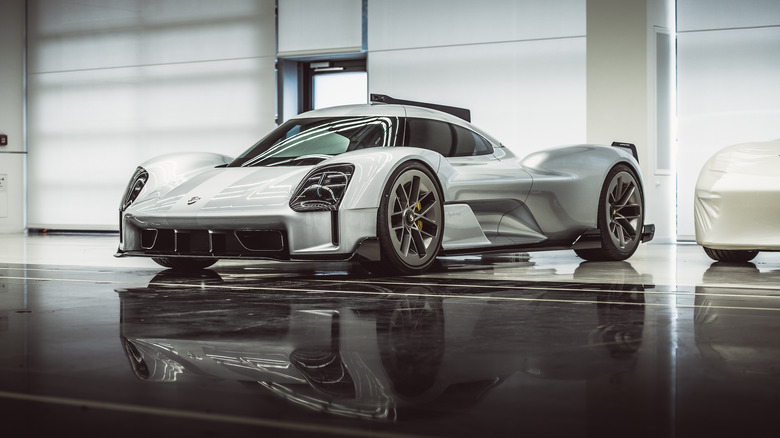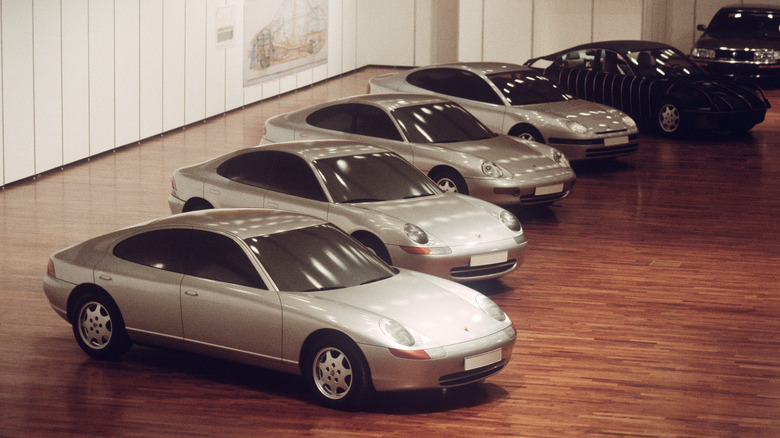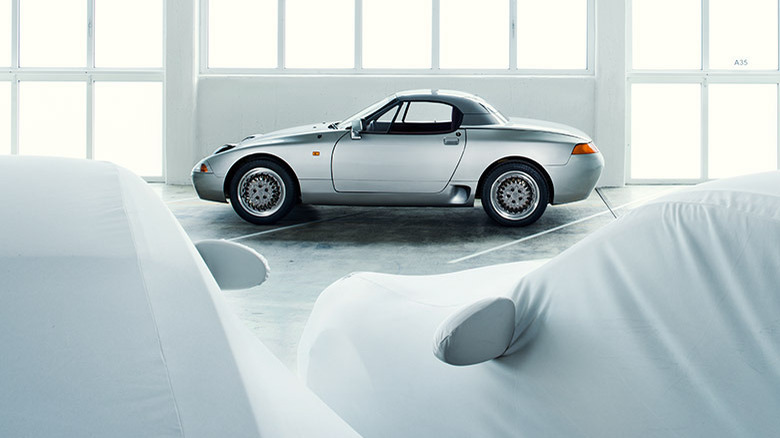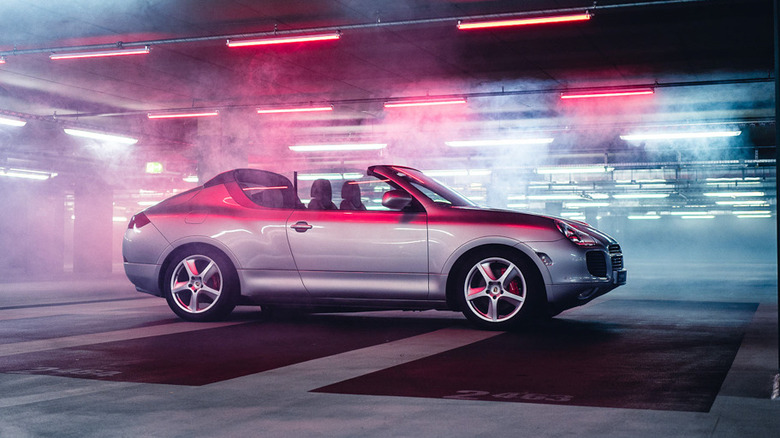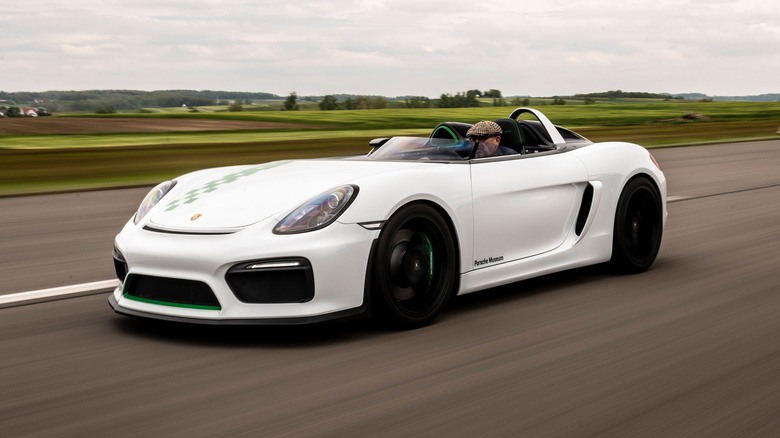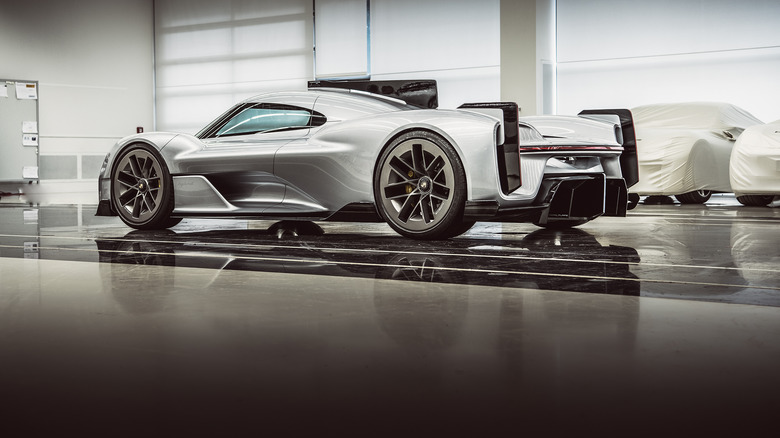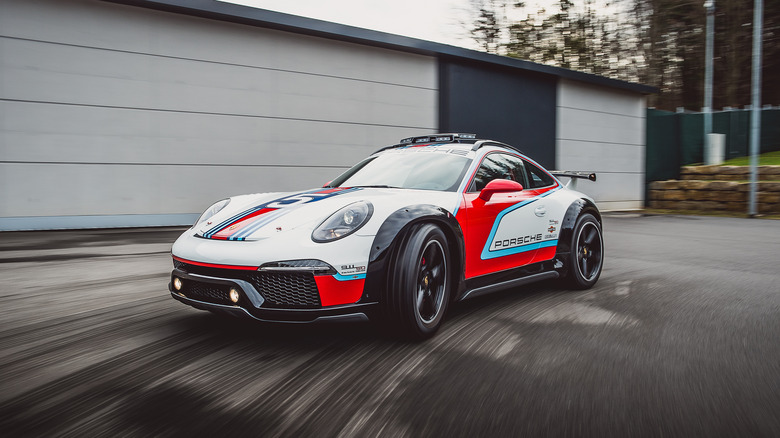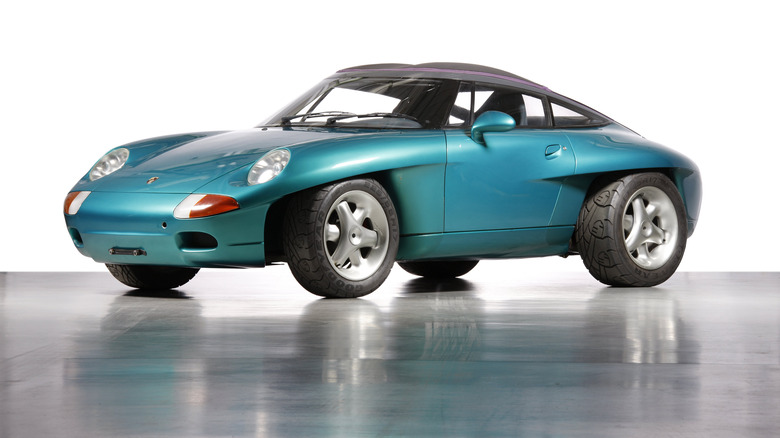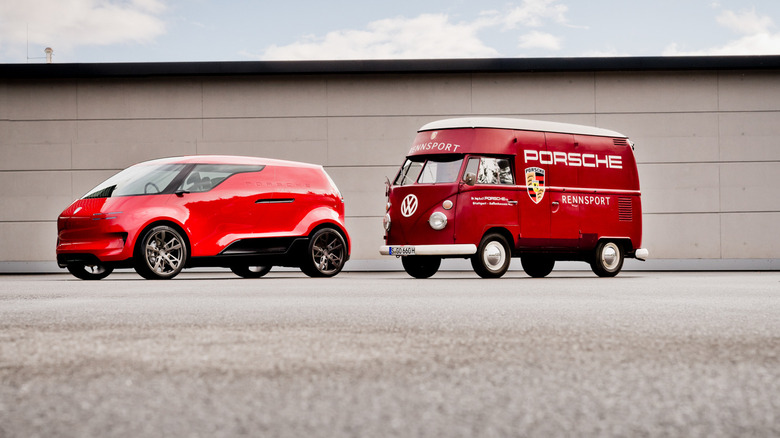Bizarre Porsche Concepts Cars That Would Be Worth A Fortune Today
Porsche's back catalog of concept cars is one of the most fascinating of any automaker, but it's not because these vehicles are so outlandish and then are never seen again. Instead, Porsche has a habit of showing concepts that at first seem utterly ridiculous, then after a few years' of hindsight, prove the idea actually made perfect sense.
Porsche likes transparancy, and in recent years has shown off the concepts that led to commercial successes like the Panamera, and even the brand-new 911 Dakar, which was seen at the 2022 L.A. Auto Show.
As with other manufacturers, it is largely impossible to put a value on these concept cars. Some can be fired up and even driven on the street, while others are models, carved out of clay and rolled into view using manpower, not horsepower.
That said, it's still fun to look back at these remarkable vehicles, understand what Porsche had in mind, and appreciate what an old concept car could be worth today — not just financially, but in terms of the value it brought to the company and the auto industry as a whole.
Porsche 989
Before the Panamera arrived in 2009, Porsche spent decades working on a four-door family sports car. The company created a four-seat 356 back in the 1950s followed by a four-door 911 prototype, then a lengthened version of the 928, which company boss Ferdinand Porsche used as his private can in the 1980s (via Porsche). The company tried again with the Type 989 concept of 1988, then again with a four-door version of the 993-generation 911.
Inspired by the successful BMW M5, the 989 was to be powered by a new eight-cylinder engine with far more power than the M5's six-cylinder motor. A 3.7-liter V8 was sourced from the Audi A8 in a bid to keep development costs under control, and the 989 was expected to launch four years later, in 1995. Porsche's own images show a concept with the face of a 996-generation 911 (which, in fact, didn't arrive until 1998), but had a higher roofline and, crucially, four doors.
Such a car makes sense today, but Porsche's finances were in poor form in the 1990s and, with a projected price double that of today's Panamera, plus the need to sell 15,000 units a year to make a profit (four times the number of M5s sold by BMW), the project was canned.
Porsche 984
Would Porsche ever offer a smaller, more affordable sports car to take on the Mazda Miata? In fact, it could have beaten Mazda to the punch had it gone ahead with the 984 concept from 1984, six years before the Miata arrived.
Porsche states: "As a small and relatively inexpensive sports car in the price range of 40,000 German marks [about $42,000 in 2022], the Porsche 984 was designed to appeal to a young, sporty clientele. The development objective was primarily focused on dynamic driving characteristics, to be achieved through low driving resistance rather than massive engine power."
The company also wanted the 984 to be fuel efficient, intending for the car to use a two-liter, four-cylinder boxer engine with 135 horsepower — a conservative output offset by a target vehicle weight of just 880 kg (via Porsche).
Porsche instead went on to create the larger and more potent Boxster and Cayman sportscars.
Cayenne convertible
One of Porsche's more unusual concepts was the convertible Cayenne SUV. This came about shortly after the first Cayenne arrived in 2002, at a time when Porsche was also considering a version with a coupe roofline, and an extended model with a third row of seats.
Porsche says, surprisingly, that the convertible "was not immediately discarded, but actually built." Today, a single example is stored in Porsche's museum, but cannot be safely driven due to it lacking the body-stiffening usually fitted to a car with its roof removed. The bizarre concept has two rear ends, with a different design on the left to the right, as evidence that the designer team couldn't all agree on how a soft-top SUV should look.
Ultimately, it didn't matter. Porsche noted: "Forecasts regarding profitability were not particularly promising and doubts remained as to whether the car would look as appealing as a Porsche should."
Had Porsche continued development of the drop-top Cayenne, it would have beaten the Range Rover Evoque convertible to market by more than a decade.
Boxster Bergspyder
Another what-if moment from Porsche comes in the form of a one-seater Boxster concept called the Bergspyder. Created in 2014, this car pays homage to the lightweight 910 Bergspyder that won the European Hillclimb Championship in 1967 and 1968. A tribute to that car, the 2014 revival was built on the 981-generation Boxster.
Porsche says: "Freed of all the trappings of comfort, with a shallow windscreen, distinctive roll bar, set of precision instruments from a Porsche 918, single seat for the driver and a helmet shelf instead of a passenger seat, the Porsche Boxster Bergspyder was ready to tackle the mountains."
The car weighed just 1,130 kg and was powered by the 3.8-liter motor of the Cayman GT4, producing 387 hp. Although only one was built, it is a functioning car and made its public debut at the Gaisberg Hillclimb in 2019, before being moved to the Porsche Museum in Stuttgart, Germany.
919 Street
What happens when you take a Le Mans-winning prototype race car, and imagine what it might look like on the road? That's what the Porsche 919 Street is. Built as a full-size clay model in 2017, the car imagined what a street-legal version of the successful Porsche 919 hybrid race car might look like.
Porsche says the car was "developed on the basis of the existing technology, promising to make the exhilarating driving experience of the LMP1 race car available to amateur drivers."
The carbon monocoque and 887 hp engine of the race car are the same, and so too are the Street's dimensions and wheelbase. Porsche didn't intend the 919 Street to be homologated as a road-going hypercar, but admits that selling a track-only version, like the McLaren Solus GT but five years earlier, may have been a reality. According to the history, "For a short while, it looked like it might be possible to build a customer car without road approval as a limited edition."
But the car was simply too complex to sell to the public, with Porsche noting that a team of mechanics needs around 45 minutes just to start such a race car. "It would have been necessary to send a team of 'flying doctors' to race tracks all over the world," the company conceded.
911 Vision Safari
Now for a Porsche concept that, just this month, became a reality. Produced as a driveable prototype back in 2012, the 911 Vision Safari paid homage to the company's rallying efforts of the 1970s. Specifically, this concept harked back to the 3,000-mile East African Safari Rally of 1978, which took place in Kenya and featured a factory-entered Porsche 911 SC Safari draped in the red and blue stripes of the iconic Martini design (via Porsche).
Built on the 991-generation 911, Porsche says that the Vision Safari featured "raised suspension, reinforced wheel housings, massive bumpers and a spartan rally cockpit with race seats and roll cage." The car even had a shelf mounted above a fan behind the seats to cool the driver's helmet between particularly warm rally stages.
Fast-forward a decade, and Porsche now offers the 911 Dakar. Based on the latest 992-generation car, it too has a raised ride height, off-road suspension, optional roof-mounted lights, and a selection of iconic rally liveries.
Panamericana
What do you buy the boss of Porsche, and son of the company's founder, for his 80th birthday? A one-off Porsche prototype, of course. This is how the unique, ready-to-drive Panamericana of 1989 came to be — a roadster design study based on the 911 Carrera 4, but with an unusual full-length sunroof that closed with a zipper.
According to Porsche, the Panamericana was powered by a 3.6-liter, six-cylinder engine producing 250 hp, and had a top speed of 130 mph. The car "combines characteristic 911 features with distinctive individuality," Porsche says, adding that the car was "completed in just a few months". The roof, although unusual with its zipper fastener, went on to influence the development of the 911 Targa, and later the Porsche Boxster.
Another detail that makes the Panamericana stand out is the semi-open wheels, which reveal how Porsche integrated its company logo into the tire tread.
Porsche Vision Renndienst
Yet another homage to its back-catalog, but this time looking at a motorsport race service van instead of a sports car. The Vision Renndienst (or "Race Service") was revealed in 2018 as an electric, six-seat van with the driver sat in the middle (via Porsche).
Although only a hand-made, full-size model was produced, Porsche was keen to look into what the future of transportation could look like, especially when semi-autonomous driving systems take over. Designers created what Porsche calls a "space shuttle" with "exciting proportions, which combines sportiness and comfortable travel in a completely new way,"
In a bid to reinvent the van and minibus, the Vision Renndienst featured a central lounge chair for the driver, "powerfully flared" wheel arches and an asymmetrical window design.
Speaking about the van, but with language that could be applied to all of the concepts featured here, Porsche said: "...such experimental visions are of essential importance for Porsche. They help to explore new possibilities and question accustomed ways of thinking and conventions. Only in this way is it possible to repeatedly reinvent the wheel."
